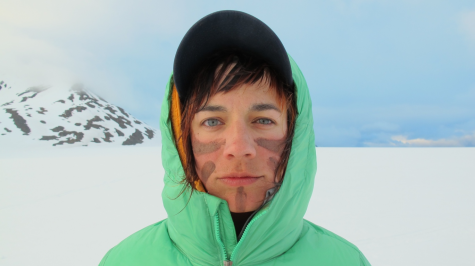Sarah dipped her fingers in mineral paint and lifted them to her face. Standing on the bold, white surface of the Harding Icefield in south-central Alaska, she painted brown-red stride-marks across wind-dried skin. We were several days into a trek by skis, ropes, sleds and backpacks, and were as far out as we’d get. She then turned to Q and me, two others in our team of five, and fixed each of our faces in her gaze, then swiped pigment on us, hydrated iron oxide the color a deep, warm blush.
The pigment came from the Southwest, something I’d wheedled out of a fine, mineral-laden clay in the Bright Angel Shale formation, northern Arizona. No more than a thumb wrapped tightly in a plastic grocery bag, I’d been carrying the dry pigment in my pack for 15 years, and would pull it out whenever the notion struck me.
Ochre is a general term for hematite, iron oxide, the ceremonial stone connected to ritual behavior at Upper Paleolithic sites around the world. I hadn’t known this when I first scraped it out of the ground. It just seemed like a good rock, easily powdered and brightly colored. The use of this particular stone goes all the way back to Neanderthal times, its use traced back at least 250,000 years. It was a popular hit in the Americas once this side of the world got started. People wet and pulverized it, painting weapons with it, leaving traces on stone tools, burying the dead drenched in its brilliant red plumes, painting cave walls and the dry rock of canyons around the world. A Russian archaeologist who pulled up a 36,000-year-old grave in Siberia, just the other side of the land bridge from here, found the pit drenched in red ochre, what he described “as bright as fire and as scarlet as blood.” An American archaeologist commented that he’d been taking an ochre-doused Clovis point to schools around the country, and even after years of being touched by students, your hands kept coming back red.
Ochre has been shown to have antiseptic properties and to inhibit some bacterial production. These qualities may have been why red ochre was used to preserve or ‘tan’ animal hides, which may be how it first became a ceremonial stone, the utilitarian turning sacred.
 Sarah painted her palm with it, and placed a red hand-print on the snow-covered icefield where around us spread several hundred square miles of white. Summits of ice-swallowed mountains stood on every horizon, our camp suspended in the middle. It might as well have been the late Pleistocene, and this is what the west side of North America looked like from here to Colorado. This was the stone of the time, a piece of ancient ritual we carried with us.
Sarah painted her palm with it, and placed a red hand-print on the snow-covered icefield where around us spread several hundred square miles of white. Summits of ice-swallowed mountains stood on every horizon, our camp suspended in the middle. It might as well have been the late Pleistocene, and this is what the west side of North America looked like from here to Colorado. This was the stone of the time, a piece of ancient ritual we carried with us.
I didn’t have much of the stuff, a small remaining stash, and she took only a nugget, enough when crushed and mixed with water to paint our three faces. Our trip leader lifted back the tent-fly to see us standing inside trenches we’d dug for our kitchens as pigment tightened our skin in a brisk breeze. “You’ve got to see this,” he said. His partner peeked through beside him, shook his head, and disappeared back into their den of man-stink and sleeping bags. “Mortal fools,” said the other man.


We are all “red paint” people. Thanks to Mr. Childs for bringing us full circle.